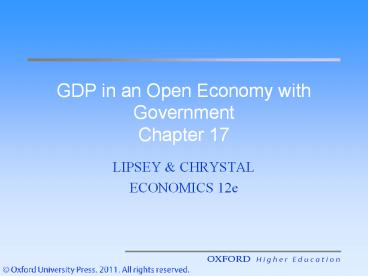GDP in an Open Economy with Government Chapter 17 - PowerPoint PPT Presentation
Title:
GDP in an Open Economy with Government Chapter 17
Description:
GDP in an Open Economy with Government Chapter 17 LIPSEY & CHRYSTAL ECONOMICS 12e Learning Outcomes Government consumption contributes to aggregate spending in the ... – PowerPoint PPT presentation
Number of Views:189
Avg rating:3.0/5.0
Title: GDP in an Open Economy with Government Chapter 17
1
GDP in an Open Economy with GovernmentChapter 17
- LIPSEY CHRYSTAL
- ECONOMICS 12e
2
Learning Outcomes
- Government consumption contributes to aggregate
spending in the same way as any other component
of autonomous spending. - Taxes affect private consumption via their effect
on disposable income. - Net exports are negatively related to domestic
income.
3
Learning Outcomes
- A necessary condition for GDP to be in
equilibrium is that desired aggregate domestic
spending is equal to national output. - The size of the multiplier is negatively related
to the income tax rate and the marginal
propensity to import.
4
GDP IN OPEN ECONOMY WITH GOVERNMENT
- Government Spending and Taxes
- Government consumption is part of autonomous
aggregate spending. - Taxes minus transfer payments are called net
taxes and affect aggregate spending indirectly. - Taxes reduce disposable income, whereas transfers
increased disposable income.
5
GDP IN OPEN ECONOMY WITH GOVERNMENT
- Government Spending and Taxes
- Disposable income, in turn, determines desired
private consumption, according to the consumption
function. - The budget balance is defined as government
revenues minus government spending. - When this difference is positive, the budget is
in surplus when it is negative, the budget is in
deficit.
6
GDP IN OPEN ECONOMY WITH GOVERNMENT
- When the budget is in surplus, there is positive
public saving, because the government is spending
less on the national product than the amount of
income that it is withdrawing from the circular
flow of income and spending. - When the government budget is in deficit, public
saving is negative.
7
GDP IN OPEN ECONOMY WITH GOVERNMENT
- Net Exports
- Since desired imports increase as national income
increases, desired net exports decrease as
national income GDP increases, other things
being equal. - Hence the net export function is negatively
sloped net exports fall as GDP rises.
8
GDP IN OPEN ECONOMY WITH GOVERNMENT
- Equilibrium GDP
- GDP is in equilibrium when desired aggregate
expenditure, C I G X - IM, equals national
output. - The sum of investment and net exports is called
national asset formation because investment is
the increase in the domestic capital stock and
net exports result in investment in foreign
assets. - At the equilibrium level of GDP, desired national
saving, S T - G, is equal to national asset
formation, I X - IM.
9
GDP IN OPEN ECONOMY WITH GOVERNMENT
- Changes in Aggregate Spending
- The size of the multiplier is negatively related
to the income tax rate. - A shift in exogenous spending changes GDP by the
value of the shift times the simple multiplier. - A shift in aggregate spending can be brought
about by fiscal policy changes or by a change in
official interest rate.
10
The budget surplus function (million)
11
Budget Surplus Function
Price Saving m
0
1000
0
2000
3000
4000
5000
6000
National Income GDPm
12
Budget Surplus Function
Price Saving m
T - G
0
-170
1000
2000
3000
4000
5000
6000
0
National Income GDPm
13
The budget surplus function
- The budget surplus is negative at low levels of
GDP and becomes positive at high levels of GDP. - Tax revenue increases with GDP while government
spending is assumed not to vary with GDP. - The slope of the budget surplus function is 0.1
when the income tax rate is assumed to be 10.
14
The net export function (million)
15
Export and Import Functions
i. Export and Import Functions
IM 0.25Y
Imports and Exports m
540
X 540
0
1000
2000
3000
Real National Income GDP m
16
Export and Import Functions
ii. Net Export Function
540
Net Exports m
2160
0
(X - IM) 540 - 0.25Y
1000
2000
3000
Real National Income GDP m
17
The net export function
- Net exports, defined as exports minus imports,
are negatively related to GDP. - Exports are assumed to be constant at 540
million while imports are 0.25 of National
income. - So the net export function is given by 540-0.25Y
18
The aggregate spending function (million)
19
An Aggregate Spending Curve and Equilibrium GDP
AE
Desired Expenditure m
2000
1060
1000
2000
3000
4000
5000
0
Real National Income GDP m
20
Aggregate expenditure
- The aggregate expenditure function is the sum of
desired consumption, investment, government
spending, and net exports. - Equilibrium GDP occurs at E0 where the desired
aggregate expenditure line intersects the 450
line. - Only when GDP is 2000 will desired spending
equal national output.
21
The Effect of Change in Government Spending
AE Y
AE1
AE0
Desired Expenditure m
45o
0
Y0
Y0
Real National Income GDP m
22
The Effect of Change in Government Spending
- A change in government spending changes GDP by
shifting the AE line parallel to its initial
position. - The initial level of AE is at AE0 and GDP is Y0
with desired expenditures at e0. - An increase in government spending raises AE to
AE1. - GDP rises to Y1 at which level desired
expenditures are e1. - The increase in GDP from Y0 to Y1 is equal to the
increase in government spending times the
multiplier.
23
UK borrowing as a of GDP (1972 to 2005)
24
UK fiscal stance as a of UK GDP
25
Exports and imports as a of UK GDP































